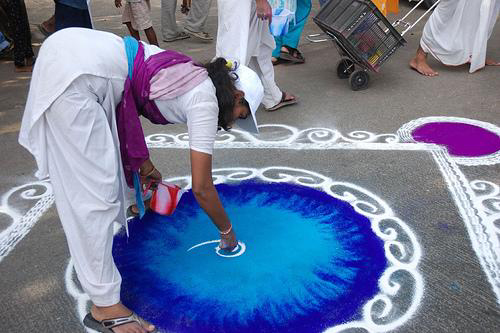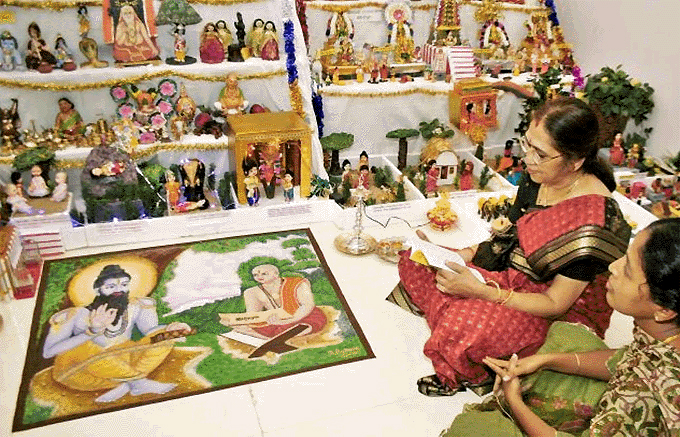
|
|
|
|
BY: SUN STAFF

Rangoli decorates a yajna kunda Feb 06, 2011 — CANADA (SUN) — A study of the historical, spiritual and cultural elements of Vedic design. In Chapter 75 of Krsna Book, 'Why Duryodhana Felt Insulted at the End of the Rajasuya Sacrifice', Srila Prabhupada relates the pastime of King Yudhisthira, sitting in the presence of Krsna in the palace built by Maya. His brother Duryodhana came to visit, and in order to foster a mood of bad feelings which would eventually escalated into the great war at Kurukshetra, Krsna arranged it so that Duryodhana would be repeatedly embarrassed and made to look foolish: "Duryodhana was decorated with a helmet, and he carried a sword in his hand. He was always in an envious and angry mood, and therefore, on a slight provocation, he spoke sharply with the doorkeepers and became angry. He was irritated because he failed to distinguish between water and land. By the craftsmanship of the demon Maya, the palace was so decorated in different places that one who did not know the tricks would consider water to be land and land to be water. Duryodhana was also illusioned by this craftsmanship, and when he was crossing water thinking it to be land, he fell down. When Duryodhana, out of his foolishness, had thus fallen, the queens enjoyed the incident by laughing. King Yudhisthira, could understand the feelings of Duryodhana, and he tried to restrain the queens from laughing, but Lord Krsna indicated that King Yudhisthira should not restrain them from enjoying the incident. Krsna desired that Duryodhana might be fooled in that way and that all of them might enjoy his foolish behavior. When everyone laughed, Duryodhana felt very insulted, and his hairs stood up in anger. Being thus insulted, he immediately left the palace, bowing his head. He was silent and did not protest. When Duryodhana left in such an angry mood, everyone regretted the incident, and King Yudhisthira also became very sorry. But despite all occurrences, Krsna was silent. He did not say anything against or in favor of the incident. It appeared that Duryodhana had been put into illusion by the supreme will of Lord Krsna, and this was the beginning of the enmity between the two sects of the Kuru dynasty. It appeared that it was a part of Krsna's plan in His mission to decrease the burden of the world." Among the methods employed in the palace decorations that made water appear to look like land and vice versa, was the painting of rangoli on the floors. One of the voices of laughter heard ringing through the halls at Duryodhana's foolishness was that of Draupadi, who taunted him by saying: "The son of a blind man can only be a blind man."

Watery rangoli field A similar incident involving Duryodhana is told in Mahabharata, where Draupadi again employed the crafty use of rangoli to bewilder him. After the Pandavas took Draupadi as a common wife they returned back to Hastinapur, where Duryodhana awaited in a jealous and angry mood, having wanted Draupadi for himself. He refused to give the kingdom back the Pandavas, so it was split, with the brothers taking Indraprastha. Having built an opulent palace for themselves, they invited the Kauravas to come and visit. Before his arrival, Draupadi had painted rangoli on the glossy floors, making them look like water, to again fool Duryodhana. Sure enough, seeing an area of floor that looked like water, Duryodhana was careful to skirt it so he wouldn't fall in. When he was told of his error – that it was only an illusion of water – he proceeded to see a real pond and thinking that it was not water, he fell in. Draupadi then laughed at him, causing him great humiliation. In order to assuage his anger, Duryodhana then vowed to take Indraprastha away from the Pandavas. While the art of rangoli was being practiced in its highest form by the likes of Draupadi and the gopis of Vrindavan, even today it is practiced masterfully by many artists around the world. In fact, because of the geometric complexities of some of the forms – particularly the South Indian kolam designs – even modern scientists are taking up the study of rangoli art.

Rangoli of Vedavyasa instructing Sri Madhva While the style of rangoli described in the Mahabharata was elevated to heights of transcendental illusion, today the art is expertly expressed in drawings that may be geometric, abstract, realist or figurative, like the image shown above of Vedavyasa and Madhvacarya. One group of Japanese academics have published a study of the graphical structures of a style of kolam called the string/knot style, which follows a distinct system of pattern formation. Some of these remarkably complex motifs are even drawn in one-stroke, the line winding around an array of carefully placed dots. Measuring various aspects of these repetitive arrays of points and connecting lines, the geometric designs are then reduced to numeric representations, churned into algorithms, and otherwise studied. There are some interesting similarities to be found between the mathematical motifs derived from the original kolam drawings, and the ways in which yantra form as geometric representations of sound vibration. We may talk more about this in a future segment.

Variations of rangoli 'diamond carpet' While the design complexities of rangoli and kolam are most interesting, more pleasurable still is the devotional mood and atmosphere in which these motifs are created. As indicated by some of the sastric references already provided, the creation of rangoli is a brahminical art in the Vaisnava culture. The asrama women typically rise, bathe, and prepare for the morning devotional activities by first creating a fresh rangoli pattern outside the front door of the home. This is often followed by worship of Tulasi. While lime and other chemical powders are often incorporated into rangoli and kolam powders today, the brahminical standard is to use rice flour, because one of the purposes of creating the rangoli outside is to feed the ants and insects. In the mood of 'cheema (ant) to Brahma', offering sustenance to the smallest entities is considered a practice respectful of all living beings, and therefore respectful of the Supreme Creator.

Brahman arranging rangoli patterns with pulses and grains
| |